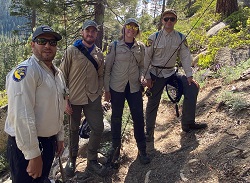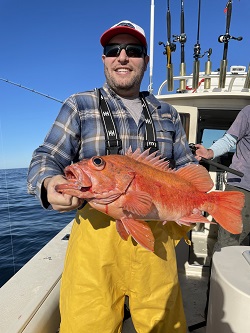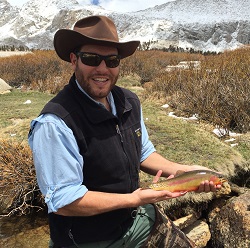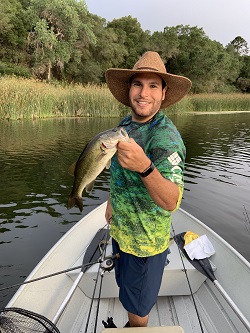Farhat electrofishes Silver Creek in Mono County to remove non-native brook trout and restore the fishery for native Lahontan cutthroat trout.

Farhat and colleagues from the Heritage and Wild Trout Program, fly rods at the ready, prepare to survey the North Fork Mokelumne River to assess the quality of trout fishing.

Away from work, Farhat is an eclectic angler shown here holding a vermillion rockfish.

Farhat with the California state freshwater fish -- the golden trout.

As a teenager growing up in the Bay Area, Farhat discovered the joys of bass fishing.
Farhat Bajjaliya is the Statewide Inland Trout Coordinator for the California Department of Fish and Wildlife (CDFW). Based out of the Fisheries Branch West Sacramento offices, Farhat oversees the high-profile Heritage and Wild Trout Program, the popular Heritage Trout Challenge, and supervises the staff who ensures CDFW’s trout stocking remains in environmental compliance.
A third-generation Palestinian-American, Farhat was born in Daly City and grew up in Concord. He studied both biology and environmental studies while earning bachelor’s degrees at Sonoma State and received his master’s degree in biological conservation from Sacramento State while working for CDFW.
Farhat joined CDFW as a scientific aid in the summer of 2007 operating rotary screw traps on the Sacramento River to survey juvenile Chinook salmon and assisted with CDFW’s second – and successful – effort to eradicate invasive northern pike from Lake Davis in Plumas County. Since then, he has held roles of increasing responsibility and leadership, including serving as the Steelhead Report and Restoration Card Coordinator and the Statewide Hatchery Coordinator before assuming his current position in 2019.
What brought you to CDFW?
I spent my childhood fishing with my father and uncles and gained a deep appreciation for the outdoors as a Boy Scout. When it came time to go to college, my father, who was a grocer at the time, encouraged me to choose a career path based on my passions, which led me to studying biology and environmental science. When I graduated, I saw that “Fish and Game” was hiring in Sacramento. The job sounded adventurous and aligned with my values, and I’ve been with the department ever since.
Where did you fish growing up?
The East Bay reservoirs – primarily San Pablo Dam and Lafayette. I spent most of my childhood plunking dough bait for trout and chicken livers for catfish. During my teenage years, I started tournament bass fishing casually with a local bass club. So, I kind of transitioned from trout and catfish to the bass world.
The head of CDFW’s Heritage and Wild Trout Program is a bass angler?
(Laughs) To be honest with you, I dabble in it all. I like to fish for trout, of course, but it really depends on the season. I really look forward to spring and early summer because striped bass are in the system, American shad start running, and black bass start warming up. I like to do it all.
What’s your vision for the Heritage and Wild Trout Program?
I think the Heritage and Wild Trout Program is one of the best programs within the department. Its mission strikes a unique balance between species conservation, resource management, angling, and public outreach. With that said, I do feel like certain aspects of the trout fishing world can be perceived as exclusionary at times. My vision includes maintaining our core mission while bolstering inclusivity. We are exploring options to rebrand and modernize the program a bit, while also providing anglers with more applicable information regarding our designated waters. I believe everyone should know about and have access to high quality heritage and wild trout angling opportunities. There is room for the purist, catch-and-release angler who only fly fishes. And, where it’s appropriate and where regulations allow, I don’t think there is necessarily anything wrong with being able to throw a lure or in some cases use bait.
What would you like trout anglers – or any angler for that matter – to know about the Heritage and Wild Trout Program today?
Take a look at our list of designated waters. Over the past 50 years, the program has identified some of the best trout spots in the state based on aesthetics, species present, fishing action and accessibility. Also, our Heritage Trout Challenge is an excellent way to explore California’s native trout within their historic ranges. Most of these fish can be caught roadside with a little research, but the more adventurous can plan day hikes or backcountry backpacking trips to find their fish. We also have a challenge guide on our website to get you started. Successful applicants receive a frameable, personalized poster and a hat. We’re nearing our 500th successful applicant and expect to reach that milestone this year.
Anglers might be familiar with some of the first designated waters, famous blue-ribbon trout streams such as Hat Creek and Fall River, even if they haven’t fished them. The California Fish and Game Commission adds new waters to the program every year based largely on your recommendations. Can you tell us about some of the more recent additions to the program we may not know as much about?
Sure. On the eastern side of the Sierra, we’ve recently added Wolf Creek. Up north, we’ve added the Fall River Complex, which includes a number of lakes, creeks and ponds within the Fall River Valley. We’ve added Butte Lake in Lassen County, and last year added the North Fork Mokelumne River. Last season was my first time going to the North Fork Mokelumne River. It has a good mixture of rainbow trout, brook trout and the occasional brown trout. Fishing there was pretty fun, and the action was pretty fast, too.
When a stream or lake is designated as a Heritage or Wild Trout Water, what changes? What does that mean?
It means it’s a unique place to fish and provides anglers with a unique experience. To qualify as a Wild Trout Water, the water has to be aesthetically pleasing, publicly accessible, provide a unique angling opportunity and does not receive a hatchery stocking allotment. Take the North Fork Mokelumne River. It received a Wild Trout Water Designation last year. That means it includes a self-sustaining population of non-native species such as brook trout or brown trout, as well as native species such as rainbow and occasional Lahontan cutthroat trout outside of their historic range. A Heritage Trout Water Designation requires a water to have only native species within their historic range. Rules and fishing regulations don’t necessarily change with either designation, but the department is required to write a management plan for the water and update that plan every five years.
What’s your favorite trout species?
My guilty pleasure are brook trout. They’re beautiful and a lot of fun to catch -- especially if you’d like to learn how to fly fish.
What advice would you give a young person interested in a career in fisheries, science or the outdoors?
If you’re fresh out of school or early on in your career, I highly recommend checking out the scientific aid positions we offer within the Heritage and Wild Trout Program. We advertise those positions on the CalCareers website around February and have a start date around the last week in May.
It’s a really unique experience to check out some backcountry locations and do some really great trout surveys. I wasn’t really aware of the scientific aid positions when I was in college, but even if you’re still in school and have the necessary units, you should think about applying so you can build that experience and be more prepared when you graduate. You get to do a lot of high-adventure field work while you’re still able to do it.
Tell us something about yourself people might be surprised to learn.
I love to deep-sea fish but get terribly seasick. It’s a struggle not having sea legs, but a patch helps and the payoff is worth it.